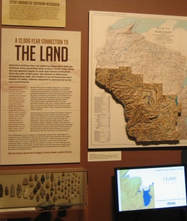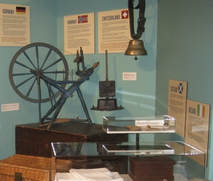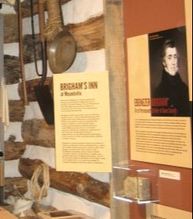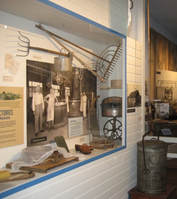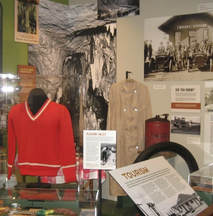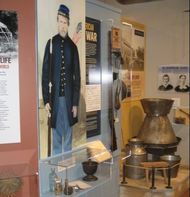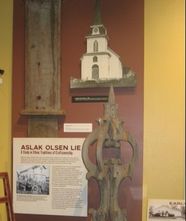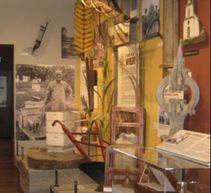EXHIBITS
The Driftless Historium is an award-winning Interpretive Center telling the story of Southwestern Dane County from pre-history to modern day. Over 3,000 square feet of space is dedicated to sharing the lives of our rich cultural heritage.
Visit all three of our exhibit areas: our Permanent Exhibit that tells this area's story through engaging graphics and carefully chosen artifacts, documents and photographs from the Society's extensive collections; rotating exhibits in our Special Exhibits Gallery (see below for a description of the latest exhibit); and changing gallery shows in the Kalscheur Family Foundation Community Room & Gallery (see below).
Also visit our virtual reality kiosk as you virtually walk through three local historical sites.
Come and share the fun, and learn about the unique Driftless Area of Wisconsin!
Hours: Sunday, Monday, Tuesday, Friday, Saturday; 10am - 4:00 pm. (Weather Closing Policy)
Visit all three of our exhibit areas: our Permanent Exhibit that tells this area's story through engaging graphics and carefully chosen artifacts, documents and photographs from the Society's extensive collections; rotating exhibits in our Special Exhibits Gallery (see below for a description of the latest exhibit); and changing gallery shows in the Kalscheur Family Foundation Community Room & Gallery (see below).
Also visit our virtual reality kiosk as you virtually walk through three local historical sites.
Come and share the fun, and learn about the unique Driftless Area of Wisconsin!
Hours: Sunday, Monday, Tuesday, Friday, Saturday; 10am - 4:00 pm. (Weather Closing Policy)
Main Gallery
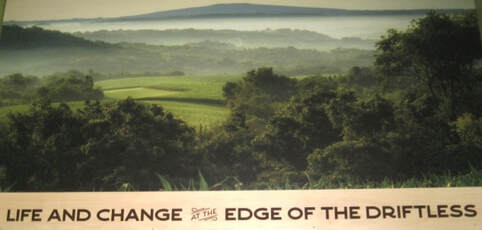
Life and Change at the Edge of the Driftless
PERMANENT EXHIBIT
This fascinating walk through history takes visitors on a journey from the great glaciers to the present.
Along the way, meet American Indians, miners, innkeepers, farmers, cheese makers, sportsmen, preachers, school teachers, shop keepers, tourists and Civilian Conservation Corps participants as you discover their stories through vivid text panels, historical documents and photographs, and hundreds of artifacts.
The 2,000 square foot exhibit incorporates all levels of the museum experience from traditional text panels to life-sized diorama settings, hands-on interactive stations to multimedia displays. There is something for all ages!
PERMANENT EXHIBIT
This fascinating walk through history takes visitors on a journey from the great glaciers to the present.
Along the way, meet American Indians, miners, innkeepers, farmers, cheese makers, sportsmen, preachers, school teachers, shop keepers, tourists and Civilian Conservation Corps participants as you discover their stories through vivid text panels, historical documents and photographs, and hundreds of artifacts.
The 2,000 square foot exhibit incorporates all levels of the museum experience from traditional text panels to life-sized diorama settings, hands-on interactive stations to multimedia displays. There is something for all ages!
A sampling of subjects you'll discover:
Get ready for your visit!
Download the companion Scavenger Hunt HERE.
Download the companion Scavenger Hunt HERE.
Special Exhibits Gallery
Included in General Admission; FREE for Members and Veterans/Active Duty Military
Included in General Admission; FREE for Members and Veterans/Active Duty Military
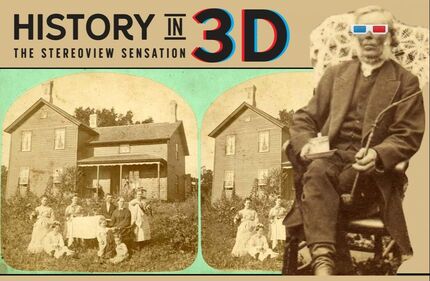
NOW SHOWING through December 2024
History in 3D: The Stereoview Sensation
Visitors don special glasses and step into a mesmerizing three-dimensional past, via forty-four historic images of the greater Mount Horeb area—converted and enlarged from their original stereoscopic format to red-and-cyan anaglyphs.
The majority of the images were selected from the extensive photographic collection of the Mount Horeb Area Historical Society, with a few select images graciously loaned by Vesterheim Norwegian American Museum & Folk Art School (Decorah, IA), Norwegian-American Historical Association (Northfield, MN), and Stoughton Historical Society (Stoughton, WI). All were re-formatted for this exhibit by local historian and exhibit designer Arlo Paust.
These photographs represent some of the earliest records of our landscapes and domestic spaces, with the majority taken by Wisconsin photographers Andreas Larsen Dahl and Samuel Nilson Rockstead in the 1870s and 1880s. They document remarkable details of village and rural life in southwestern Dane County. In particular, exhibit guests will see Norwegian immigrant families who were in the process of transitioning to life as Americans.
Within the gallery, original artifacts demonstrate the timeline of three-dimensional imagery: from the then-ubiquitous Victorian stereoscopic viewer, to mid-century stereoscopic personal cameras, to the kitschy Magic Eye books of the 1990s, and immersive 3D movies of today.
Furthermore, an interactive kids’ corner encourages the young and the young at heart to experience another popular iteration of 3D imagery, the Viewmaster, a toybox staple that has captivated American children for generations.
Finally, “History in 3D” is extended into the present, with a companion display of modern stereoscopic views by Mount Horeb’s own Michael Pecosky. Though Michael might consider himself an amateur, his work has captured numerous accolades and awards, including 2016 Best of Show by the National Stereoscopic Association.
History in 3D: The Stereoview Sensation
Visitors don special glasses and step into a mesmerizing three-dimensional past, via forty-four historic images of the greater Mount Horeb area—converted and enlarged from their original stereoscopic format to red-and-cyan anaglyphs.
The majority of the images were selected from the extensive photographic collection of the Mount Horeb Area Historical Society, with a few select images graciously loaned by Vesterheim Norwegian American Museum & Folk Art School (Decorah, IA), Norwegian-American Historical Association (Northfield, MN), and Stoughton Historical Society (Stoughton, WI). All were re-formatted for this exhibit by local historian and exhibit designer Arlo Paust.
These photographs represent some of the earliest records of our landscapes and domestic spaces, with the majority taken by Wisconsin photographers Andreas Larsen Dahl and Samuel Nilson Rockstead in the 1870s and 1880s. They document remarkable details of village and rural life in southwestern Dane County. In particular, exhibit guests will see Norwegian immigrant families who were in the process of transitioning to life as Americans.
Within the gallery, original artifacts demonstrate the timeline of three-dimensional imagery: from the then-ubiquitous Victorian stereoscopic viewer, to mid-century stereoscopic personal cameras, to the kitschy Magic Eye books of the 1990s, and immersive 3D movies of today.
Furthermore, an interactive kids’ corner encourages the young and the young at heart to experience another popular iteration of 3D imagery, the Viewmaster, a toybox staple that has captivated American children for generations.
Finally, “History in 3D” is extended into the present, with a companion display of modern stereoscopic views by Mount Horeb’s own Michael Pecosky. Though Michael might consider himself an amateur, his work has captured numerous accolades and awards, including 2016 Best of Show by the National Stereoscopic Association.
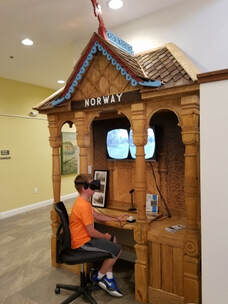
VIRTUAL TOUR of the Mount Horeb Area
View the exterior, interior and grounds of the Norway Building, constructed for the 1893 Chicago World's Fair.
At the end of the fair, the building was moved to a Lake Geneva, Wisconsin, estate later owned by the Wrigley family of chewing-gum fame. Eventually it was moved to Little Norway, a local attraction in rural Blue Mounds where generations of visitors experienced its unique charms. Several years after Little Norway closed to the public, the building was moved back to Orkanger, Norway, where it was originally created.
Weeks before the Norway Building was dismantled and moved back to Norway, researchers at UW-Madison's Wisconsin Institute for Discovery scanned the structure and recreated it as a high resolution, 3D reconstruction. Using state-of-the-art technology, visitors to the Driftless Historium can once again experience this unique building as they virtually "walk" through and around the Norway Building at our 3D kiosk.
Also on view are 3D reconstructions of the historic Springdale Lutheran Church and a local "hanging" dairy barn, now part of Rare Earth Farm, owned and cared for by Charles Bauer and Charles Beckwith.
View the exterior, interior and grounds of the Norway Building, constructed for the 1893 Chicago World's Fair.
At the end of the fair, the building was moved to a Lake Geneva, Wisconsin, estate later owned by the Wrigley family of chewing-gum fame. Eventually it was moved to Little Norway, a local attraction in rural Blue Mounds where generations of visitors experienced its unique charms. Several years after Little Norway closed to the public, the building was moved back to Orkanger, Norway, where it was originally created.
Weeks before the Norway Building was dismantled and moved back to Norway, researchers at UW-Madison's Wisconsin Institute for Discovery scanned the structure and recreated it as a high resolution, 3D reconstruction. Using state-of-the-art technology, visitors to the Driftless Historium can once again experience this unique building as they virtually "walk" through and around the Norway Building at our 3D kiosk.
Also on view are 3D reconstructions of the historic Springdale Lutheran Church and a local "hanging" dairy barn, now part of Rare Earth Farm, owned and cared for by Charles Bauer and Charles Beckwith.
Kalscheur Family Foundation Community Room & Gallery
Temporary changing exhibits, often featuring local artists, are FREE and accessible during regular museum hours.
Temporary changing exhibits, often featuring local artists, are FREE and accessible during regular museum hours.

NOW SHOWING through Tuesday, July 30, 2024
"Unraveling Reflections" fea. 2024 Student Spotlight Artists Lizzy Helin and Anja Rathje
The Driftless Historium’s Student Spotlight program celebrates the talent of area youth. This mentor-driven initiative, now in its 5th year, provides an opportunity for young artists, selected by committee from a pool of applicants, to gain experience producing and promoting a public art installation in a professional setting. It was developed in partnership with MHHS Art Department educators Anna King and Dana Showers, with funding provided by the Mount Horeb Area Historical Society.
While exploring exhibition themes for their joint show, 2024 Artists Lizzy Helin and Anja Rathje were quick to agree that art was their haven from and a reflection of the often-overwhelming experience of young adulthood. Their exhibition statement describes the artistic process as a route to “unravel[ing] the complexities of ourselves, other people, and the world”; a way to “disentangle our conflicts and clarify what is true.”
“Unraveling Reflections” includes a variety of artistic mediums and styles, each representing this creative and cathartic interpretation of reality.
The Student Spotlight program will serve as a steppingstone for the recently graduated Rathje, who plans to pursue a BFA in Studio Art; and it underscores the validity of outgoing junior Helin’s aspirations of a future art degree.
"Unraveling Reflections" is FREE and open to the public during regular museum hours (Friday through Tuesday, 10:00 a.m. to 4:00p.m.). For more information call 608-437-6486 or email [email protected].
"Unraveling Reflections" fea. 2024 Student Spotlight Artists Lizzy Helin and Anja Rathje
The Driftless Historium’s Student Spotlight program celebrates the talent of area youth. This mentor-driven initiative, now in its 5th year, provides an opportunity for young artists, selected by committee from a pool of applicants, to gain experience producing and promoting a public art installation in a professional setting. It was developed in partnership with MHHS Art Department educators Anna King and Dana Showers, with funding provided by the Mount Horeb Area Historical Society.
While exploring exhibition themes for their joint show, 2024 Artists Lizzy Helin and Anja Rathje were quick to agree that art was their haven from and a reflection of the often-overwhelming experience of young adulthood. Their exhibition statement describes the artistic process as a route to “unravel[ing] the complexities of ourselves, other people, and the world”; a way to “disentangle our conflicts and clarify what is true.”
“Unraveling Reflections” includes a variety of artistic mediums and styles, each representing this creative and cathartic interpretation of reality.
The Student Spotlight program will serve as a steppingstone for the recently graduated Rathje, who plans to pursue a BFA in Studio Art; and it underscores the validity of outgoing junior Helin’s aspirations of a future art degree.
"Unraveling Reflections" is FREE and open to the public during regular museum hours (Friday through Tuesday, 10:00 a.m. to 4:00p.m.). For more information call 608-437-6486 or email [email protected].

NOW SHOWING in the Wall Case through Tuesday, July 30, 2024
Trollabration: A Joyful Observance of Mount Horeb’s Most (In)Famous Residents”
To accompany the Driftless Historium’s debut of the *all-new* (and always FREE) mini-Troll Museum, “Trollabration” is an intriguing mix of artwork, artifacts and historic photographs celebrating those mysterious characters that have become our Village’s best-known—if least understood—asset.
This exhibit incorporates a variety of troll-related and inspired items from the Mount Horeb Area Historical Society collection, including troll kitsch (troll-themed monopoly, troll-painted plates), troll art by Oleanna Cunneen and Pat Edmondson, the troll mascot of former downtown retail favorite The Cat and Crow, and more!
“Trollabration” is FREE and open to the public during regular museum hours (Friday through Tuesday, 10:00 a.m. to 4:00p.m.). For more information call 608-437-6486 or email [email protected].
Trollabration: A Joyful Observance of Mount Horeb’s Most (In)Famous Residents”
To accompany the Driftless Historium’s debut of the *all-new* (and always FREE) mini-Troll Museum, “Trollabration” is an intriguing mix of artwork, artifacts and historic photographs celebrating those mysterious characters that have become our Village’s best-known—if least understood—asset.
This exhibit incorporates a variety of troll-related and inspired items from the Mount Horeb Area Historical Society collection, including troll kitsch (troll-themed monopoly, troll-painted plates), troll art by Oleanna Cunneen and Pat Edmondson, the troll mascot of former downtown retail favorite The Cat and Crow, and more!
“Trollabration” is FREE and open to the public during regular museum hours (Friday through Tuesday, 10:00 a.m. to 4:00p.m.). For more information call 608-437-6486 or email [email protected].

